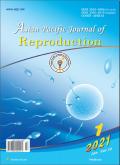菲律宾小型人工授精公猪细菌精子症及其潜在相关因素
IF 0.6
Q4 REPRODUCTIVE BIOLOGY
引用次数: 0
摘要
目的:了解当地小农人工授精操作人员采集的猪精液中细菌精子症的流行情况、细菌载量及可能的细菌污染因素。方法:从菲律宾Leyte第5区不同的小农猪运营商拥有的当地可获得的人工授精公猪中收集了15个单独的生精液样本,并进行了标准的细菌培养和鉴定,包括对潜在相关因素的调查。据此确定流行率和细菌数量,同时采用聚类分层聚类技术对公猪特征和收集做法进行聚类。结果:污染100%,细菌计数为(2.01±0.38)×103 CFU/mL。至少73.33%的样本检出芽孢杆菌阳性,其他检出的菌株包括肠杆菌、葡萄球菌、大肠杆菌、假单胞菌、柠檬酸杆菌和克雷伯氏菌。结论:尽管菌精率较高,但细菌数量较低。然而,在小农人工授精操作中,应认真考虑猪场卫生和管理、精液收集和卫生以及加强控制污染的基本规程方面的做法。本文章由计算机程序翻译,如有差异,请以英文原文为准。
Bacteriospermia among smallholder artificial insemination boars in the Philippines and potential associated factors
Objective: To determine the prevalence of bacteriospermia, the bacterial load, and the potential factors associated with bacterial contamination in boar semen collected by local smallholder artificial insemination operators. Methods: Fifteen individual raw semen samples were collected from locally available artificial insemination boars owned by different smallholder boar operators within the 5th district of Leyte, Philippines and were subjected to standard bacteriological culture and identification, including a survey of potentially associated factors. Prevalence and bacterial count were determined accordingly, while boar characteristics and collection practices were clustered following agglomerative hierarchical clustering technique. Results: One hundred percent contamination with a bacterial count of (2.01±0.38)×103 CFU/mL was observed. At least 73.33% of the samples were positive for Bacillus spp., while other identified isolates included Enterobacter spp., Staphylococcus spp., E. coli, Pseudomonas spp., Citrobacter spp., and Klebsiella spp. Conclusions: Despite the high prevalence of bacteriospermia, the bacterial count is low. Nevertheless, on-farm practices on boar health and management, semen collection, and sanitation as well as the enhancement of basic protocols to control contamination should be conscientiously considered in smallholder artificial insemination operation.
求助全文
通过发布文献求助,成功后即可免费获取论文全文。
去求助
来源期刊

Asian Pacific Journal of Reproduction
Veterinary-Veterinary (all)
CiteScore
1.70
自引率
0.00%
发文量
588
审稿时长
9 weeks
期刊介绍:
The journal will cover technical and clinical studies related to health, ethical and social issues in field of Gynecology and Obstetrics. Articles with clinical interest and implications will be given preference.
 求助内容:
求助内容: 应助结果提醒方式:
应助结果提醒方式:


